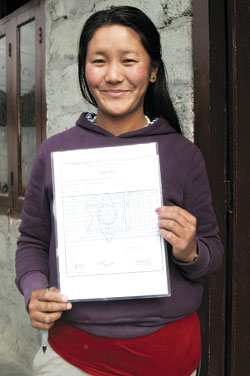 HAPPY GRADUATE: Rinzin Wangmo says it isn't just about the certificate. "I want to serve the local people as much as possible, as the other amchis do," she says. |
"Medicine is passed down like a religious lineage, from father to son. It is also like a dance and a game. People offer what they know, sometimes adding new ideas from what they have seen and done. In our tradition, we learn to take from our teacher's ideas and our books to create new ideas, which come into full bloom like a lotus flower when combined with the soil of experience."
Gyatso Bista, Co-founder of Lo Kunphen Medical School, Upper Mustang
For brothers Gyatso and Tenzin Bista, Rinzin Wangmo could well be a lotus flower coming into bloom. She is the first government-recognised Community Amchi Assistant (CAA) of Himalayan Traditional Medicine (HMT) in Nepal. Teaching her juniors in Lo Kunphen Medical School and treating locals in the surrounding communities, she is carrying on an ancient tradition that might have been lost in Nepal if not for the efforts of the Bistas.
There was a time when there were about 30 traditional amchis (practitioners of traditional Tibetan medicine) in Mustang, approximately one for every village. Now there are only seven, the inevitable result of out-migration and a shift towards a cash-based economy that undervalues indigenous knowledge provided for free through masters and apprentices.
Expert amchi practitioners and hereditary physician astrologers to the Mustangi King in Lo-Manthang, Gyatso and Tenzin Bista, picked the threat to this millennia-old tradition early.
They then founded Lo Kunphen Medical School in 2000 and designed a two-year CAA curriculum for Class Eight graduates. Now they are looking to upgrade the HMT course to a Certificate in Amchi Medicine for CAA or SLC graduates.
HMT is based on the herbal and natural products of Tibet and the Himalaya, and is a rigorous discipline that has been practiced for thousands of years. Practitioners develop a close relationship with their patients, and attend to chronic conditions such as hepatitis and diabetes, incorporating diagnosis by pulse and urine analysis and holistic treatment combining physical and spiritual wellness.
In the age of modern medicine, some aspects of HMT - particularly its focus on Buddhist philosophy - may seem a little antiquated. But it is sometimes the only treatment available to locals in remote areas such as Dolpo, Upper Mustang and Mugu. What's more, the services are provided for free by practitioners, old and new, mirroring the ideal of the Bodhisattva who sacrifices personal benefit for that of the community.
 |
It's widely acknowledged that Nepal has among the richest diversity of medicinal plants in the world. A strong, government-accredited community of amchis - linked with practitioners in Tibet, Ladakh, Bhutan and Mongolia - could prove essential to promoting sustainable utilisation of our ecological resources. This in turn could tie into a strategy for regional and international marketing of HMT that could provide the financial resources for its continued development, and that of the traditional communities that constitute its heartland.
Yoji Kamata


